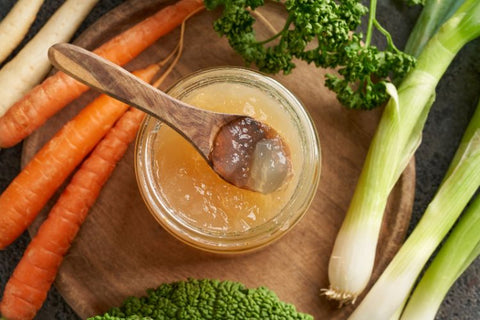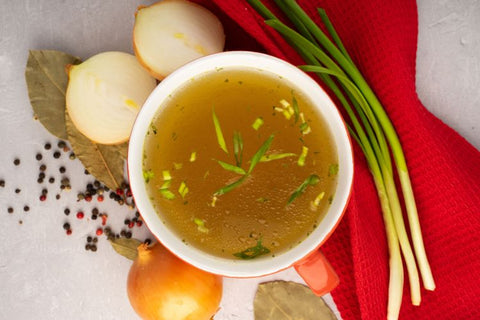In recent years, bone broth powder has gained significant popularity as a convenient and nutritious alternative to traditional bone broth. However, achieving the perfect blend of bone broth powder can be an art in itself. This article aims to guide readers through the essential techniques of properly mixing bone broth powder to create a delicious and satisfying beverage or ingredient. Here are the following steps:
1. Start with Warm Liquid
While it might seem intuitive to use boiling water for bone broth powder, opting for warm liquid offers several advantages:
Dissolving Efficiency:
- Hydration: Bone broth powder is concentrated, containing a high amount of protein and collagen. Boiling water can cause these components to clump together, making it difficult to achieve a smooth and even distribution. Warm water (around 120°F to 140°F / 49°C to 60°C) allows for gentler hydration, promoting easier dissolving and a smoother consistency.
Flavor Preservation:
- Heat Sensitivity: Bone broth boasts a rich and complex flavour profile derived from the slow extraction of nutrients from bones and vegetables. Boiling water can damage these delicate flavour compounds, leading to a flat or dull taste. Warmer liquids extract the desired flavours without compromising their subtlety.
The ideal temperature range for mixing bone broth powder falls between 120°F and 140°F (49°C and 60°C). This range provides the following benefits:
- Optimal Hydration: Warm water is hot enough to efficiently hydrate the protein and collagen in the powder, ensuring a smooth and consistent broth.
- Flavour Protection: It avoids excessive heat that can damage the delicate flavour compounds, preserving the full depth and richness of the bone broth.
2. Stir Gradually to Avoid Clumping
Adding bone broth powder slowly while stirring continuously plays a crucial role in achieving a smooth, lump-free consistency. Here's why:
- Preventing Clumps: Bone broth powder is concentrated, and adding it all at once to warm water can lead to clumping. The powder tends to absorb water quickly on the surface, forming dense pockets that are difficult to break down later.
- Even Hydration: Slow addition allows each portion of the powder to come into contact with the water gradually. This ensures even hydration throughout the mixture, preventing localized areas from becoming overly concentrated and forming clumps.
- Breaking Up Particles: Continuous stirring helps break down any small clumps that might form as the powder hydrates. The motion distributes the powder particles throughout the liquid, preventing them from sticking together.
Tips for Lump-Free Consistency
- Slow and Steady: Add the bone broth powder a tablespoon at a time, allowing enough time for each addition to fully incorporate before adding more.
- Whisk it Good: Use a whisk to continuously stir the mixture as you add the powder. This helps break up any clumps that might form and ensures even distribution throughout the liquid.
- Bloom Beforehand (Optional): For an extra smooth consistency, consider "blooming" the powder before adding it to the main liquid. Briefly whisk the powder with a small amount of cool or room-temperature water to create a thick paste. Then, slowly whisk this paste into the warm water for a head start on even hydration.
3. Use of Whisk or Blender
While stirring with a spoon can achieve a decent consistency, using a whisk or blender offers significant advantages for creating an even smoother and more enjoyable bone broth:
Enhanced Clump-Breaking Power:
- Whisk's Reach: A whisk's design, with its multiple wire loops, allows it to reach into all corners of the mixing vessel. This ensures a more thorough incorporation of the powder throughout the liquid, effectively breaking down any small clumps that might form during the addition process.
- Blender's Power: A blender takes clump-busting to another level. Its powerful blades quickly spin and shear the mixture, breaking down even stubborn clumps and achieving a silky-smooth texture.
Improved Texture and Mouthfeel:
- Whisk's Smoothing Action: As you whisk, the constant agitation helps disperse the hydrated powder particles throughout the broth. This creates a smoother mouthfeel, eliminating any grainy texture that might arise from incompletely dissolved powder.
- Blender's Emulsification: A blender not only breaks down clumps but also emulsifies the broth. This means it helps disperse any fats present in the powder, leading to a creamier and more luxurious texture in the final beverage.
4. Allow Time for Dissolution
While it might be tempting to dive right in after mixing your bone broth powder, a touch of patience can significantly improve the final product. Here's why waiting for complete dissolution is important:
- Improved Flavor: Some bone broth powders contain small flavour particles that take a little extra time to fully release their essence. Waiting allows these flavours to bloom and disperse throughout the broth, resulting in a richer and more complex taste profile.
- Smooth Texture: Even with proper mixing techniques, there's a chance of microscopic particles not being fully hydrated immediately. Allowing the mixture to sit for a short while gives these particles extra time to absorb water and ensures a perfectly smooth and enjoyable broth.
Recommended Waiting Time
The ideal waiting time for complete dissolution can vary slightly depending on the specific brand of bone broth powder you're using. However, a general recommendation falls between 2-5 minutes. Here's a breakdown:
- 2-3 Minutes: This is a good starting point for most bone broth powders. It allows sufficient time for most particles to fully hydrate and flavours to develop.
- Up to 5 Minutes: If you're using a particularly dense powder or prefer an extra smooth texture, consider waiting up to 5 minutes. This extended time ensures complete hydration and a luxuriously smooth broth.
5. Mixing with Room Temperature Liquid
While bone broth is traditionally enjoyed warm, it can be a refreshing and flavorful addition to cold beverages as well. Here's how to mix bone broth powder for a delicious cold drink:
Ingredients:
- Bone Broth Powder (desired amount)
- Room Temperature Liquid (water, coconut water, unsweetened almond milk, etc.)
- Ice (optional)
Instructions:
-
Choose Your Liquid: Decide on the base for your cold drink. Opt for plain water for a classic flavour, or choose unsweetened almond milk, coconut water, or even sparkling water for a touch of variety. Ensure the liquid is at room temperature, not cold.
-
Mix the Powder: Using a whisk or a blender, follow the general guidelines for mixing bone broth powder with warm liquids as outlined previously. Slowly add the desired amount of powder to the room-temperature liquid while continuously stirring or blending.
- Tip: For cold beverages, you might find slightly less powder is needed compared to a warm broth. Start with a half serving and adjust to your taste preference.
-
Complete Hydration: Allow the mixture to sit for 2-3 minutes to ensure complete dissolution of the powder particles. This waiting time will improve both the texture and flavour of your cold drink.
- Chill and Enjoy: Once the powder is fully dissolved, add ice to your liking and refrigerate your bone broth beverage for at least 30 minutes to achieve a refreshing chill.
6. Experimenting with Ratios
The beauty of bone broth powder lies in its versatility. By adjusting the ratio of powder to liquid, you can customize the flavour intensity and richness of your broth to suit your taste preferences.
Understanding the Ratio:
Bone broth powder manufacturers typically recommend a specific ratio of powder to water on the packaging. This is a good starting point, but feel free to experiment to find your perfect balance.
Adjusting for Flavor Intensity:
- Stronger Flavor: If you prefer a more robust and flavorful broth, simply increase the amount of powder you use per serving. Start by adding ¼ to ½ tablespoon more powder than the recommended amount and taste-test as you go.
- Milder Flavor: For a subtler and lighter-flavored broth, use slightly less powder than recommended. Reduce the amount by ¼ to ½ tablespoon at a time until you reach your desired taste.
Ratio and Richness:
The ratio also affects the perceived richness of the broth. Here's a general guideline:
- More Powder, Richer Broth: Using a higher amount of powder per cup of liquid will result in a richer and thicker broth. This is ideal for those who enjoy a more concentrated flavour profile.
- Less Powder, Lighter Broth: Conversely, using less powder creates a lighter and thinner broth. This might be preferable if you plan to use the broth as a base for soups or stews where you'll be adding other flavorful ingredients.
7. Incorporating Additional Ingredients
Bone broth powder offers a delicious base, but incorporating herbs, spices, and other flavourings can elevate it to a truly satisfying and personalized experience. Here are some tips for adding these extras:
Choosing the Right Ingredients:
- Fresh vs. Dried: Both fresh and dried herbs and spices work well with bone broth. Fresh herbs tend to have a brighter flavour, while dried offer a more concentrated aroma. Choose based on your preference and what you have readily available.
- Flavour Profiles: Consider the overall flavour profile you're aiming for. Popular options include:
- Warmth and Depth: Rosemary, thyme, black pepper, garlic powder, ginger
- Asian-inspired: Lemongrass, ginger, garlic, a squeeze of lime juice
- Mediterranean Touch: Fresh oregano, basil, a pinch of red pepper flakes
- Citrusy Zing: Lemon or lime zest, a squeeze of fresh juice
The order and method of adding your flavourings significantly impact the final result. Here's why gradual incorporation is important:
- Even Distribution: Adding herbs and spices gradually allows for a more even distribution of flavour throughout the broth. If you add everything at once, some ingredients might overpower others, leading to an unbalanced taste.
- Layering Flavors: Starting with base flavours like garlic and ginger allows them to gently infuse the broth. Then, adding more delicate herbs like parsley or cilantro towards the end ensures their fresh notes remain prominent.
8. Blending with Food in Recipes
Bone broth powder's versatility extends far beyond a simple cup of warm broth. Here are some creative ways to integrate this nutrient-rich ingredient into various dishes:
- Soup Booster: Elevate your favourite soups by adding a spoonful of bone broth powder along with your broth or water base. This intensifies the savoury depth and adds a welcome boost of nutrients.
- Stew Savior: Incorporate bone broth powder during the simmering stage of stews and chilis. It not only deepens the flavour profile but also adds protein and collagen to the final dish.
- Saucy Secrets: Sneak some bone broth powder into your pan sauces for meat, fish, or vegetables. It thickens the sauce slightly while adding a layer of savoury richness.
- Grainy Goodness: Liven up your rice, quinoa, or couscous by using bone broth powder instead of plain water for cooking. This infuses the grains with additional flavour and protein.
9. Pre-dissolving Technique
The technique of pre-dissolving a small amount of bone broth powder with a minimal amount of liquid before incorporating it into your main broth offers several advantages, particularly for achieving a smooth and consistent final product.
Challenges of Direct Addition:
Adding bone broth powder directly to a large volume of water can lead to a few common issues:
- Clumping: Bone broth powder is concentrated and tends to clump together when added directly to water. These clumps can be difficult to break down completely, resulting in a lumpy texture in the final broth.
- Uneven Distribution: Adding a large amount of powder at once makes it harder to ensure it distributes evenly throughout the liquid. This can lead to pockets of highly concentrated powder alongside areas with less flavour.
Benefits of Pre-Dissolving:
Pre-dissolving a small portion of the powder with a minimal amount of liquid (like cool or room temperature water) offers a more controlled approach:
- Smoother Consistency: The initial mixing with a small amount of liquid creates a "slurry" or paste. This allows the powder particles to hydrate more readily, minimizing the formation of clumps and leading to a smoother final broth.
- Better Control: By creating a concentrated paste, you have more control over the distribution and intensity of the flavour. You can gradually add the paste to your main broth, tasting it as you go, and adjust the amount for a perfect flavour profile.
How Much Liquid to Use:
The ideal amount of liquid for pre-dissolving is just enough to create a smooth paste. Typically, a tablespoon or two of cool or room-temperature water is sufficient for a single serving of bone broth powder.
When to Use This Technique:
Pre-dissolving is particularly beneficial:
- For larger batches: When mixing a large amount of bone broth powder, pre-dissolving ensures even distribution and prevents clumping throughout the entire volume.
- For achieving a very smooth texture: If a silky-smooth consistency is your goal, pre-dissolving helps break down even the smallest particles, leading to a luxurious mouthfeel.
10. Straining if Necessary
While pre-dissolving and careful mixing techniques can often achieve a smooth consistency, there might be situations where you desire an even more refined texture. Straining your bone broth powder mixture can be a helpful step in these cases:
Benefits of Straining:
- Removing Fine Particles: Bone broth powder, especially certain brands, might contain small vegetable or spice particles that don't fully dissolve during mixing. Straining removes these fine particles, resulting in a silky-smooth broth with a luxurious mouthfeel.
- Enhanced Clarity: Straining can also remove any residual fat or foam that may have formed during mixing, leading to a clearer and more visually appealing broth.
When to Consider Straining:
Straining isn't always necessary, but it's a good option if:
- You prefer a super-smooth texture: For a truly silky-smooth broth, straining removes any remaining particles that might affect the mouthfeel.
- Your powder contains visible spices or herbs: If your bone broth powder includes larger chunks of spices or herbs that you prefer not to consume, straining will remove them while retaining the flavour they impart.
- You're using the broth for a specific purpose: For certain recipes or presentations, a clear and smooth broth might be desired. Straining can help achieve this aesthetic.
Steps for Straining:
- Choose Your Strainer: A fine-mesh strainer is ideal for straining bone broth powder. You can also line a regular strainer with cheesecloth for an even finer filtering process.
- Let it Settle (Optional): While not essential, allowing your mixed broth to sit for 5-10 minutes can allow any larger particles to settle at the bottom. This makes straining slightly easier.
- Pour Slowly: Slowly pour your bone broth mixture through the chosen strainer over a bowl or pot to collect the clarified broth.
- Gently Press (Optional): For a completely clear broth, you can gently press the solids remaining in the strainer with the back of a spoon to extract any remaining liquid. However, avoid pressing too hard, as this might extract unwanted bitterness from any spices or herbs.
Conclusion
In conclusion, mastering the art of mixing bone broth powder involves careful technique and creativity. Starting with warm liquid, stirring gradually, and using tools like whisks or blenders can create a delicious and satisfying beverage or ingredient. Experiment with ratios and additional ingredients to customize flavours. Bone broth powder offers versatility and nutritional benefits, enhancing various recipes. Embrace the journey of discovering the possibilities of bone broth powder for nourishing and flavorful meals.






